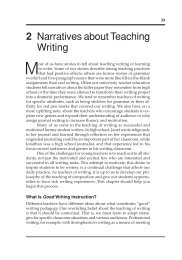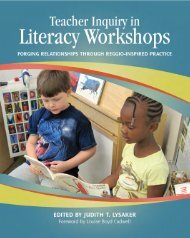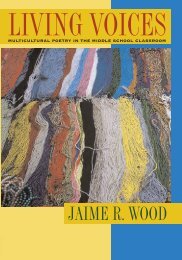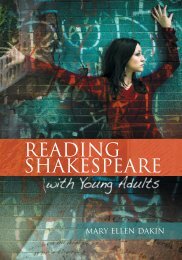Graphic novel Spread - National Council of Teachers of English
Graphic novel Spread - National Council of Teachers of English
Graphic novel Spread - National Council of Teachers of English
- No tags were found...
Create successful ePaper yourself
Turn your PDF publications into a flip-book with our unique Google optimized e-Paper software.
24 James Bucky Carter<br />
Liu, J. (2004). Effects <strong>of</strong> comic strips on L2 learners’ reading comprehension.<br />
TESOL Quarterly, 38, 225–45.<br />
Marsh, J., & Millard, E. (2000). Literacy and popular culture: Using children’s<br />
culture in the classroom. London: Paul Chapman.<br />
Mayer, R. E. (1999). Research-based principles for the design <strong>of</strong> instructional<br />
messages: The case for multimedia explanations. Document Design, 1,<br />
7–20.<br />
McCloud, S. (1999). Understanding Comics. New York: DC Comics.<br />
Meacham, S. J., & Buendia, E.. (1999). Modernism, postmodernism, and poststructuralism<br />
and their impact on literacy. Language Arts, 76, 510–16.<br />
Mendez, T. (2004, October 12). ‘Hamlet’ too hard Try a comic book. Christian<br />
Science Monitor. Retrieved March 25, 2005, from http://<br />
www.csmonitor.com<br />
Mitchell, J. P., & George, J. D. (1996). What do Superman, Captain America,<br />
and Spiderman have in common The case for comic books. Gifted<br />
Education International, 11, 91–94.<br />
Moore, A., & Gibbons, D. (1987). Watchmen. New York: DC Comics.<br />
Morrison, T. G., Bryan, G., & Chilcoat, G. W. (2002). Using student-generated<br />
comic books in the classroom. Journal <strong>of</strong> Adolescent & Adult Literacy, 45,<br />
758–67.<br />
Murray, C. (1997). Reading comics: Narrative and visual discourse in comics.<br />
Paper presented at the Scottish Word and Image Group Conference.<br />
Retrieved November 30, 2003, from Http://www.dundee.ac.uk/<br />
english/swig/papers.htm.<br />
Myers, M. (1996). Changing our minds: Negotiating <strong>English</strong> and literacy. Urbana,<br />
IL: NCTE.<br />
NCTE. (2005). Multimodal literacies. Retrieved January 14, 2006, from http:/<br />
/www.ncte.org/about/over/positions/category/media/123213.htm<br />
Reid, C. (2002). Asian comics delight U.S. readers. Publishers Weekly, 249(51),<br />
26.<br />
Schwarz, G. E. (2002). <strong>Graphic</strong> <strong>novel</strong>s for multiple literacies. Journal <strong>of</strong><br />
Adolescent & Adult Literacy, 46, 262–65. Retrieved (in PDF) October 13,<br />
2003, from EBSCO, 1–4.<br />
Smith, M. W., & Wilhelm, J. D. (2002). Reading don’t fix no chevys. Portsmouth,<br />
NH: Heinemann.<br />
Spiegelman, A. (1986). Maus I. A survivor’s tale. New York: Pantheon.<br />
Spiegelman, A. (1991). Maus II. A survivor’s tale. New York: Pantheon.<br />
Toppo, G. (2005, March 3). <strong>Teachers</strong> are getting graphic. USA Today. Retrieved<br />
March 11, 2005, from http://www.usatoday.com<br />
Vygotsky, L. S. (1978). Mind in society: The development <strong>of</strong> higher psychological<br />
processes. Cambridge, MA: Harvard University Press.
















